Essay on Gender Inequality in the UK: Social Inequalities in Britain
VerifiedAdded on 2023/04/22
|13
|2542
|178
Essay
AI Summary
This essay provides a comprehensive analysis of gender inequality in the United Kingdom, focusing on inequalities within the family and employability sectors. It draws upon feminist perspectives, including liberal and radical feminism, to examine the historical and contemporary manifestations of gender inequality. The essay discusses how traditional societal constructs, such as the division of labor based on gender and emphasized masculinity, contribute to the problem. It further explores the gender pay gap, limited career prospects for women, and the impact of government initiatives like the Equal Pay Act and Sex Discrimination Act. The essay concludes that while progress has been made, gender inequality remains a significant issue in the UK, affecting women's opportunities and overall well-being. Desklib provides access to similar solved assignments and past papers for students.
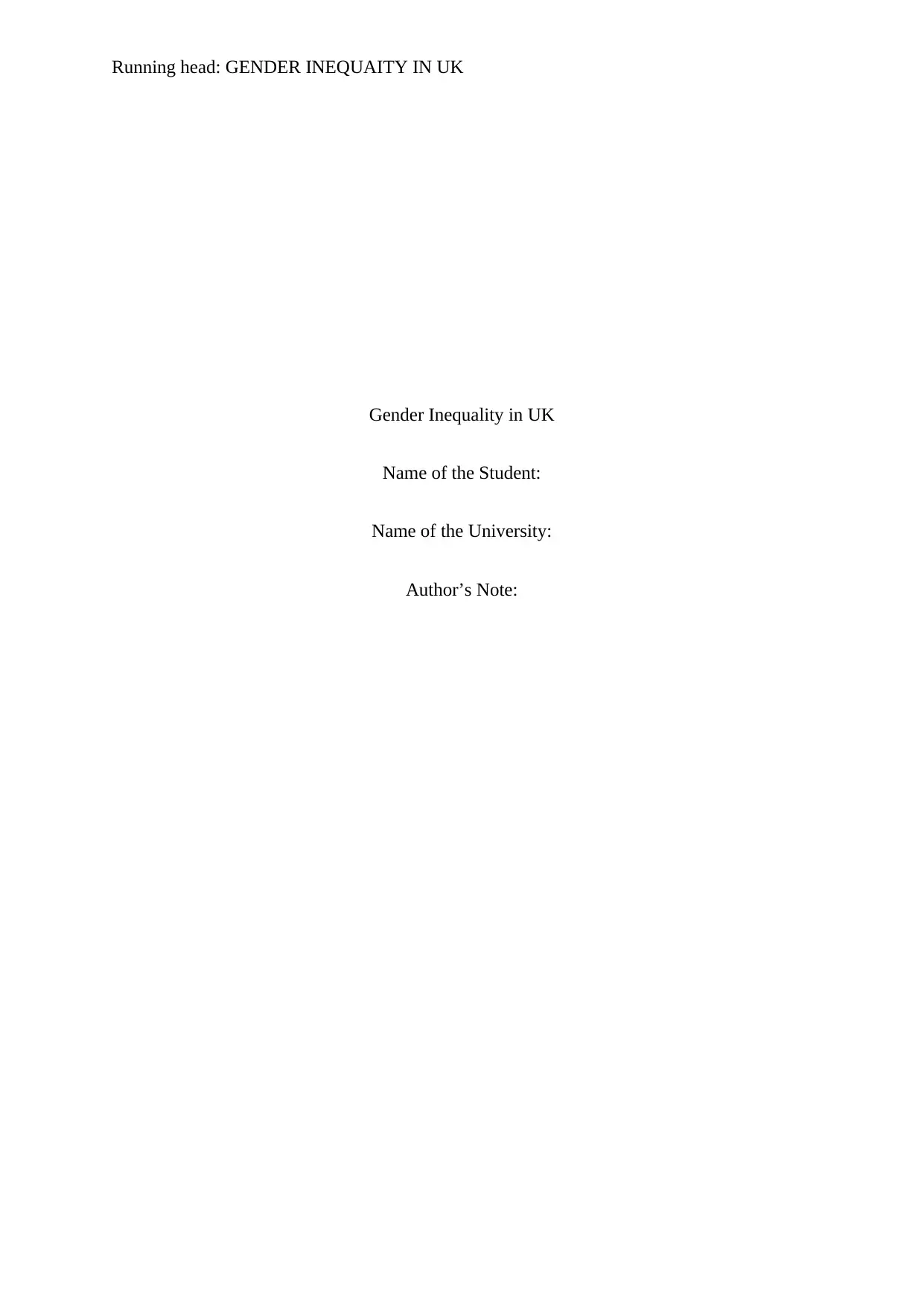
Running head: GENDER INEQUAITY IN UK
Gender Inequality in UK
Name of the Student:
Name of the University:
Author’s Note:
Gender Inequality in UK
Name of the Student:
Name of the University:
Author’s Note:
Paraphrase This Document
Need a fresh take? Get an instant paraphrase of this document with our AI Paraphraser
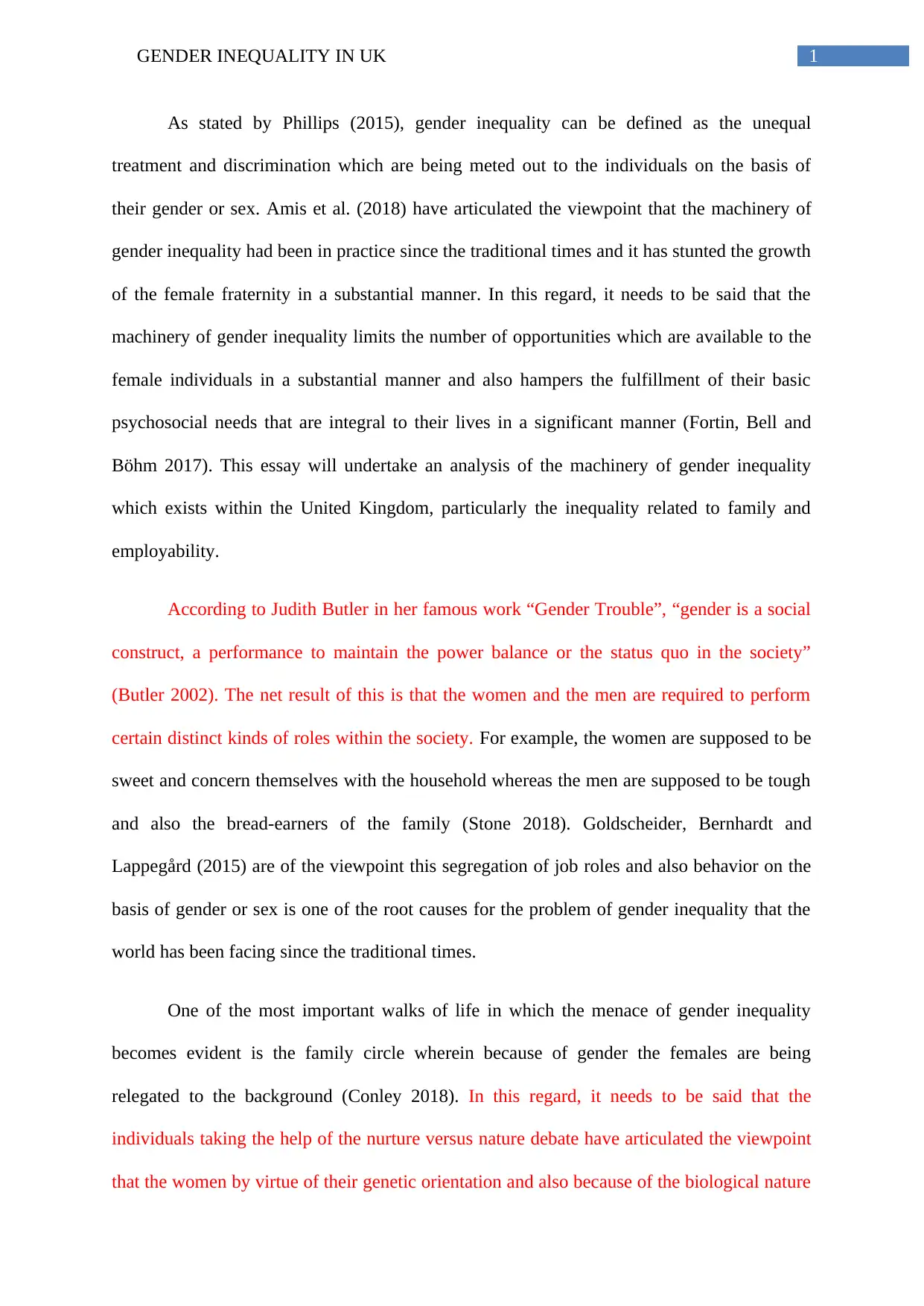
1GENDER INEQUALITY IN UK
As stated by Phillips (2015), gender inequality can be defined as the unequal
treatment and discrimination which are being meted out to the individuals on the basis of
their gender or sex. Amis et al. (2018) have articulated the viewpoint that the machinery of
gender inequality had been in practice since the traditional times and it has stunted the growth
of the female fraternity in a substantial manner. In this regard, it needs to be said that the
machinery of gender inequality limits the number of opportunities which are available to the
female individuals in a substantial manner and also hampers the fulfillment of their basic
psychosocial needs that are integral to their lives in a significant manner (Fortin, Bell and
Böhm 2017). This essay will undertake an analysis of the machinery of gender inequality
which exists within the United Kingdom, particularly the inequality related to family and
employability.
According to Judith Butler in her famous work “Gender Trouble”, “gender is a social
construct, a performance to maintain the power balance or the status quo in the society”
(Butler 2002). The net result of this is that the women and the men are required to perform
certain distinct kinds of roles within the society. For example, the women are supposed to be
sweet and concern themselves with the household whereas the men are supposed to be tough
and also the bread-earners of the family (Stone 2018). Goldscheider, Bernhardt and
Lappegård (2015) are of the viewpoint this segregation of job roles and also behavior on the
basis of gender or sex is one of the root causes for the problem of gender inequality that the
world has been facing since the traditional times.
One of the most important walks of life in which the menace of gender inequality
becomes evident is the family circle wherein because of gender the females are being
relegated to the background (Conley 2018). In this regard, it needs to be said that the
individuals taking the help of the nurture versus nature debate have articulated the viewpoint
that the women by virtue of their genetic orientation and also because of the biological nature
As stated by Phillips (2015), gender inequality can be defined as the unequal
treatment and discrimination which are being meted out to the individuals on the basis of
their gender or sex. Amis et al. (2018) have articulated the viewpoint that the machinery of
gender inequality had been in practice since the traditional times and it has stunted the growth
of the female fraternity in a substantial manner. In this regard, it needs to be said that the
machinery of gender inequality limits the number of opportunities which are available to the
female individuals in a substantial manner and also hampers the fulfillment of their basic
psychosocial needs that are integral to their lives in a significant manner (Fortin, Bell and
Böhm 2017). This essay will undertake an analysis of the machinery of gender inequality
which exists within the United Kingdom, particularly the inequality related to family and
employability.
According to Judith Butler in her famous work “Gender Trouble”, “gender is a social
construct, a performance to maintain the power balance or the status quo in the society”
(Butler 2002). The net result of this is that the women and the men are required to perform
certain distinct kinds of roles within the society. For example, the women are supposed to be
sweet and concern themselves with the household whereas the men are supposed to be tough
and also the bread-earners of the family (Stone 2018). Goldscheider, Bernhardt and
Lappegård (2015) are of the viewpoint this segregation of job roles and also behavior on the
basis of gender or sex is one of the root causes for the problem of gender inequality that the
world has been facing since the traditional times.
One of the most important walks of life in which the menace of gender inequality
becomes evident is the family circle wherein because of gender the females are being
relegated to the background (Conley 2018). In this regard, it needs to be said that the
individuals taking the help of the nurture versus nature debate have articulated the viewpoint
that the women by virtue of their genetic orientation and also because of the biological nature
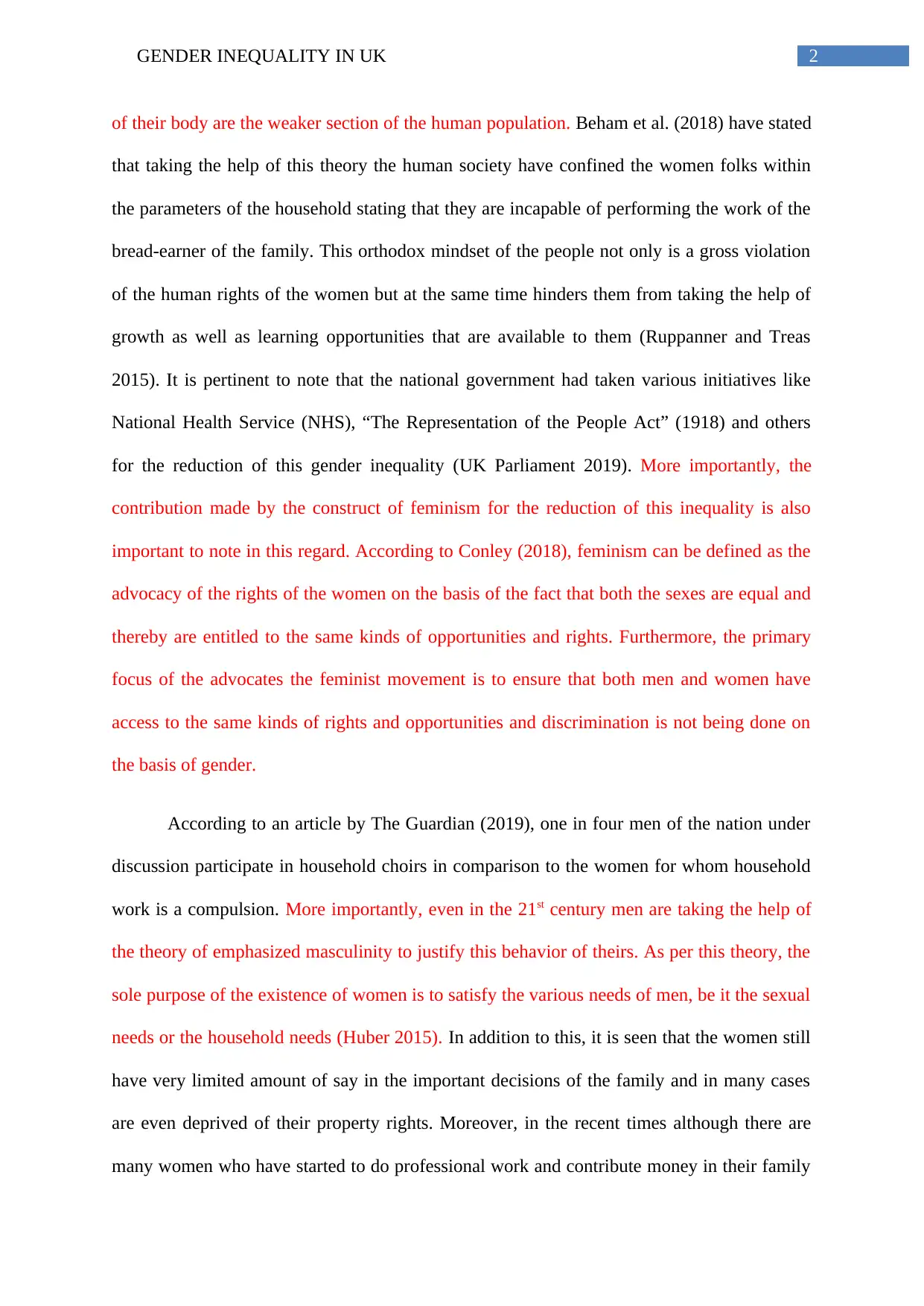
2GENDER INEQUALITY IN UK
of their body are the weaker section of the human population. Beham et al. (2018) have stated
that taking the help of this theory the human society have confined the women folks within
the parameters of the household stating that they are incapable of performing the work of the
bread-earner of the family. This orthodox mindset of the people not only is a gross violation
of the human rights of the women but at the same time hinders them from taking the help of
growth as well as learning opportunities that are available to them (Ruppanner and Treas
2015). It is pertinent to note that the national government had taken various initiatives like
National Health Service (NHS), “The Representation of the People Act” (1918) and others
for the reduction of this gender inequality (UK Parliament 2019). More importantly, the
contribution made by the construct of feminism for the reduction of this inequality is also
important to note in this regard. According to Conley (2018), feminism can be defined as the
advocacy of the rights of the women on the basis of the fact that both the sexes are equal and
thereby are entitled to the same kinds of opportunities and rights. Furthermore, the primary
focus of the advocates the feminist movement is to ensure that both men and women have
access to the same kinds of rights and opportunities and discrimination is not being done on
the basis of gender.
According to an article by The Guardian (2019), one in four men of the nation under
discussion participate in household choirs in comparison to the women for whom household
work is a compulsion. More importantly, even in the 21st century men are taking the help of
the theory of emphasized masculinity to justify this behavior of theirs. As per this theory, the
sole purpose of the existence of women is to satisfy the various needs of men, be it the sexual
needs or the household needs (Huber 2015). In addition to this, it is seen that the women still
have very limited amount of say in the important decisions of the family and in many cases
are even deprived of their property rights. Moreover, in the recent times although there are
many women who have started to do professional work and contribute money in their family
of their body are the weaker section of the human population. Beham et al. (2018) have stated
that taking the help of this theory the human society have confined the women folks within
the parameters of the household stating that they are incapable of performing the work of the
bread-earner of the family. This orthodox mindset of the people not only is a gross violation
of the human rights of the women but at the same time hinders them from taking the help of
growth as well as learning opportunities that are available to them (Ruppanner and Treas
2015). It is pertinent to note that the national government had taken various initiatives like
National Health Service (NHS), “The Representation of the People Act” (1918) and others
for the reduction of this gender inequality (UK Parliament 2019). More importantly, the
contribution made by the construct of feminism for the reduction of this inequality is also
important to note in this regard. According to Conley (2018), feminism can be defined as the
advocacy of the rights of the women on the basis of the fact that both the sexes are equal and
thereby are entitled to the same kinds of opportunities and rights. Furthermore, the primary
focus of the advocates the feminist movement is to ensure that both men and women have
access to the same kinds of rights and opportunities and discrimination is not being done on
the basis of gender.
According to an article by The Guardian (2019), one in four men of the nation under
discussion participate in household choirs in comparison to the women for whom household
work is a compulsion. More importantly, even in the 21st century men are taking the help of
the theory of emphasized masculinity to justify this behavior of theirs. As per this theory, the
sole purpose of the existence of women is to satisfy the various needs of men, be it the sexual
needs or the household needs (Huber 2015). In addition to this, it is seen that the women still
have very limited amount of say in the important decisions of the family and in many cases
are even deprived of their property rights. Moreover, in the recent times although there are
many women who have started to do professional work and contribute money in their family
⊘ This is a preview!⊘
Do you want full access?
Subscribe today to unlock all pages.

Trusted by 1+ million students worldwide
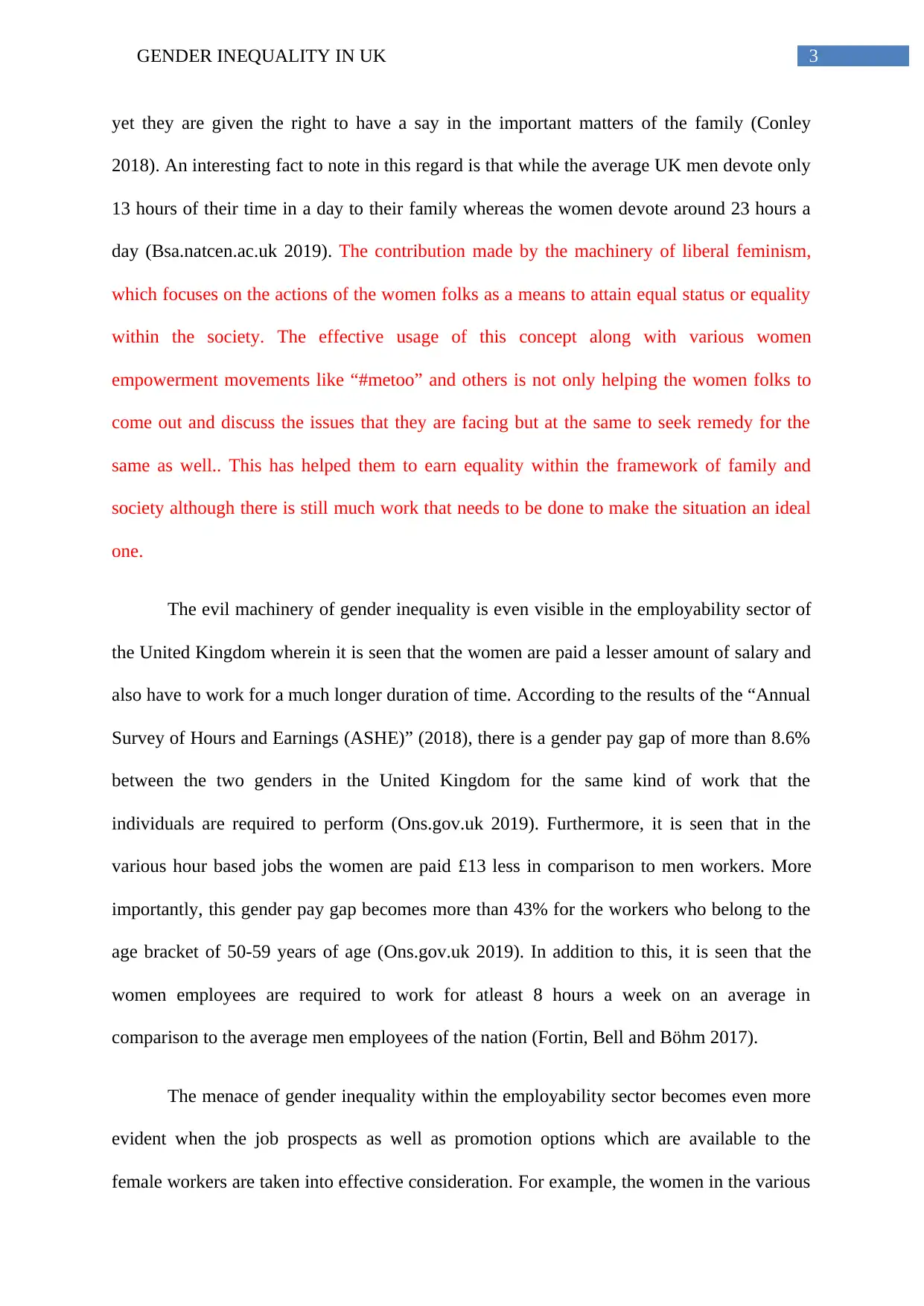
3GENDER INEQUALITY IN UK
yet they are given the right to have a say in the important matters of the family (Conley
2018). An interesting fact to note in this regard is that while the average UK men devote only
13 hours of their time in a day to their family whereas the women devote around 23 hours a
day (Bsa.natcen.ac.uk 2019). The contribution made by the machinery of liberal feminism,
which focuses on the actions of the women folks as a means to attain equal status or equality
within the society. The effective usage of this concept along with various women
empowerment movements like “#metoo” and others is not only helping the women folks to
come out and discuss the issues that they are facing but at the same to seek remedy for the
same as well.. This has helped them to earn equality within the framework of family and
society although there is still much work that needs to be done to make the situation an ideal
one.
The evil machinery of gender inequality is even visible in the employability sector of
the United Kingdom wherein it is seen that the women are paid a lesser amount of salary and
also have to work for a much longer duration of time. According to the results of the “Annual
Survey of Hours and Earnings (ASHE)” (2018), there is a gender pay gap of more than 8.6%
between the two genders in the United Kingdom for the same kind of work that the
individuals are required to perform (Ons.gov.uk 2019). Furthermore, it is seen that in the
various hour based jobs the women are paid £13 less in comparison to men workers. More
importantly, this gender pay gap becomes more than 43% for the workers who belong to the
age bracket of 50-59 years of age (Ons.gov.uk 2019). In addition to this, it is seen that the
women employees are required to work for atleast 8 hours a week on an average in
comparison to the average men employees of the nation (Fortin, Bell and Böhm 2017).
The menace of gender inequality within the employability sector becomes even more
evident when the job prospects as well as promotion options which are available to the
female workers are taken into effective consideration. For example, the women in the various
yet they are given the right to have a say in the important matters of the family (Conley
2018). An interesting fact to note in this regard is that while the average UK men devote only
13 hours of their time in a day to their family whereas the women devote around 23 hours a
day (Bsa.natcen.ac.uk 2019). The contribution made by the machinery of liberal feminism,
which focuses on the actions of the women folks as a means to attain equal status or equality
within the society. The effective usage of this concept along with various women
empowerment movements like “#metoo” and others is not only helping the women folks to
come out and discuss the issues that they are facing but at the same to seek remedy for the
same as well.. This has helped them to earn equality within the framework of family and
society although there is still much work that needs to be done to make the situation an ideal
one.
The evil machinery of gender inequality is even visible in the employability sector of
the United Kingdom wherein it is seen that the women are paid a lesser amount of salary and
also have to work for a much longer duration of time. According to the results of the “Annual
Survey of Hours and Earnings (ASHE)” (2018), there is a gender pay gap of more than 8.6%
between the two genders in the United Kingdom for the same kind of work that the
individuals are required to perform (Ons.gov.uk 2019). Furthermore, it is seen that in the
various hour based jobs the women are paid £13 less in comparison to men workers. More
importantly, this gender pay gap becomes more than 43% for the workers who belong to the
age bracket of 50-59 years of age (Ons.gov.uk 2019). In addition to this, it is seen that the
women employees are required to work for atleast 8 hours a week on an average in
comparison to the average men employees of the nation (Fortin, Bell and Böhm 2017).
The menace of gender inequality within the employability sector becomes even more
evident when the job prospects as well as promotion options which are available to the
female workers are taken into effective consideration. For example, the women in the various
Paraphrase This Document
Need a fresh take? Get an instant paraphrase of this document with our AI Paraphraser
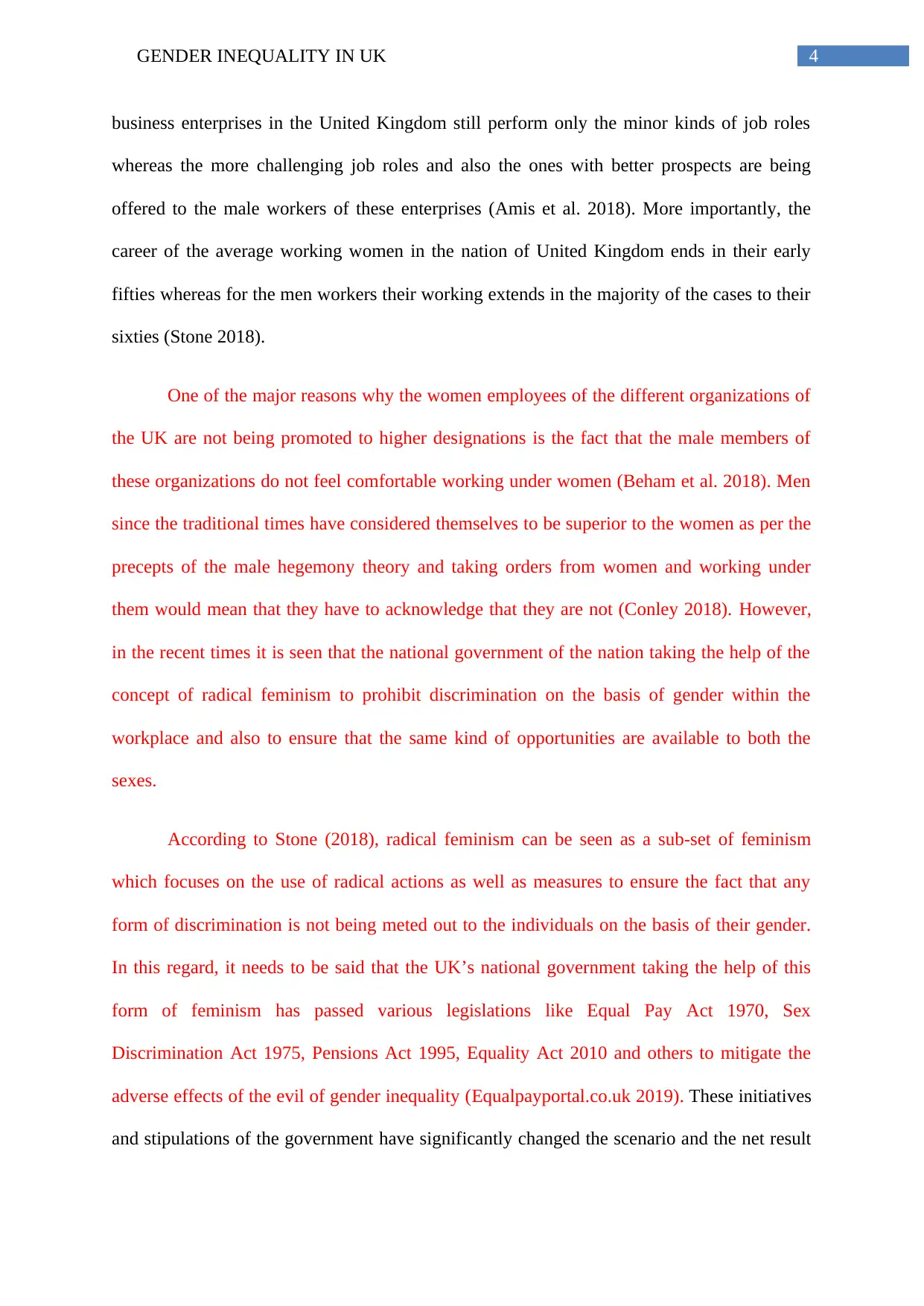
4GENDER INEQUALITY IN UK
business enterprises in the United Kingdom still perform only the minor kinds of job roles
whereas the more challenging job roles and also the ones with better prospects are being
offered to the male workers of these enterprises (Amis et al. 2018). More importantly, the
career of the average working women in the nation of United Kingdom ends in their early
fifties whereas for the men workers their working extends in the majority of the cases to their
sixties (Stone 2018).
One of the major reasons why the women employees of the different organizations of
the UK are not being promoted to higher designations is the fact that the male members of
these organizations do not feel comfortable working under women (Beham et al. 2018). Men
since the traditional times have considered themselves to be superior to the women as per the
precepts of the male hegemony theory and taking orders from women and working under
them would mean that they have to acknowledge that they are not (Conley 2018). However,
in the recent times it is seen that the national government of the nation taking the help of the
concept of radical feminism to prohibit discrimination on the basis of gender within the
workplace and also to ensure that the same kind of opportunities are available to both the
sexes.
According to Stone (2018), radical feminism can be seen as a sub-set of feminism
which focuses on the use of radical actions as well as measures to ensure the fact that any
form of discrimination is not being meted out to the individuals on the basis of their gender.
In this regard, it needs to be said that the UK’s national government taking the help of this
form of feminism has passed various legislations like Equal Pay Act 1970, Sex
Discrimination Act 1975, Pensions Act 1995, Equality Act 2010 and others to mitigate the
adverse effects of the evil of gender inequality (Equalpayportal.co.uk 2019). These initiatives
and stipulations of the government have significantly changed the scenario and the net result
business enterprises in the United Kingdom still perform only the minor kinds of job roles
whereas the more challenging job roles and also the ones with better prospects are being
offered to the male workers of these enterprises (Amis et al. 2018). More importantly, the
career of the average working women in the nation of United Kingdom ends in their early
fifties whereas for the men workers their working extends in the majority of the cases to their
sixties (Stone 2018).
One of the major reasons why the women employees of the different organizations of
the UK are not being promoted to higher designations is the fact that the male members of
these organizations do not feel comfortable working under women (Beham et al. 2018). Men
since the traditional times have considered themselves to be superior to the women as per the
precepts of the male hegemony theory and taking orders from women and working under
them would mean that they have to acknowledge that they are not (Conley 2018). However,
in the recent times it is seen that the national government of the nation taking the help of the
concept of radical feminism to prohibit discrimination on the basis of gender within the
workplace and also to ensure that the same kind of opportunities are available to both the
sexes.
According to Stone (2018), radical feminism can be seen as a sub-set of feminism
which focuses on the use of radical actions as well as measures to ensure the fact that any
form of discrimination is not being meted out to the individuals on the basis of their gender.
In this regard, it needs to be said that the UK’s national government taking the help of this
form of feminism has passed various legislations like Equal Pay Act 1970, Sex
Discrimination Act 1975, Pensions Act 1995, Equality Act 2010 and others to mitigate the
adverse effects of the evil of gender inequality (Equalpayportal.co.uk 2019). These initiatives
and stipulations of the government have significantly changed the scenario and the net result
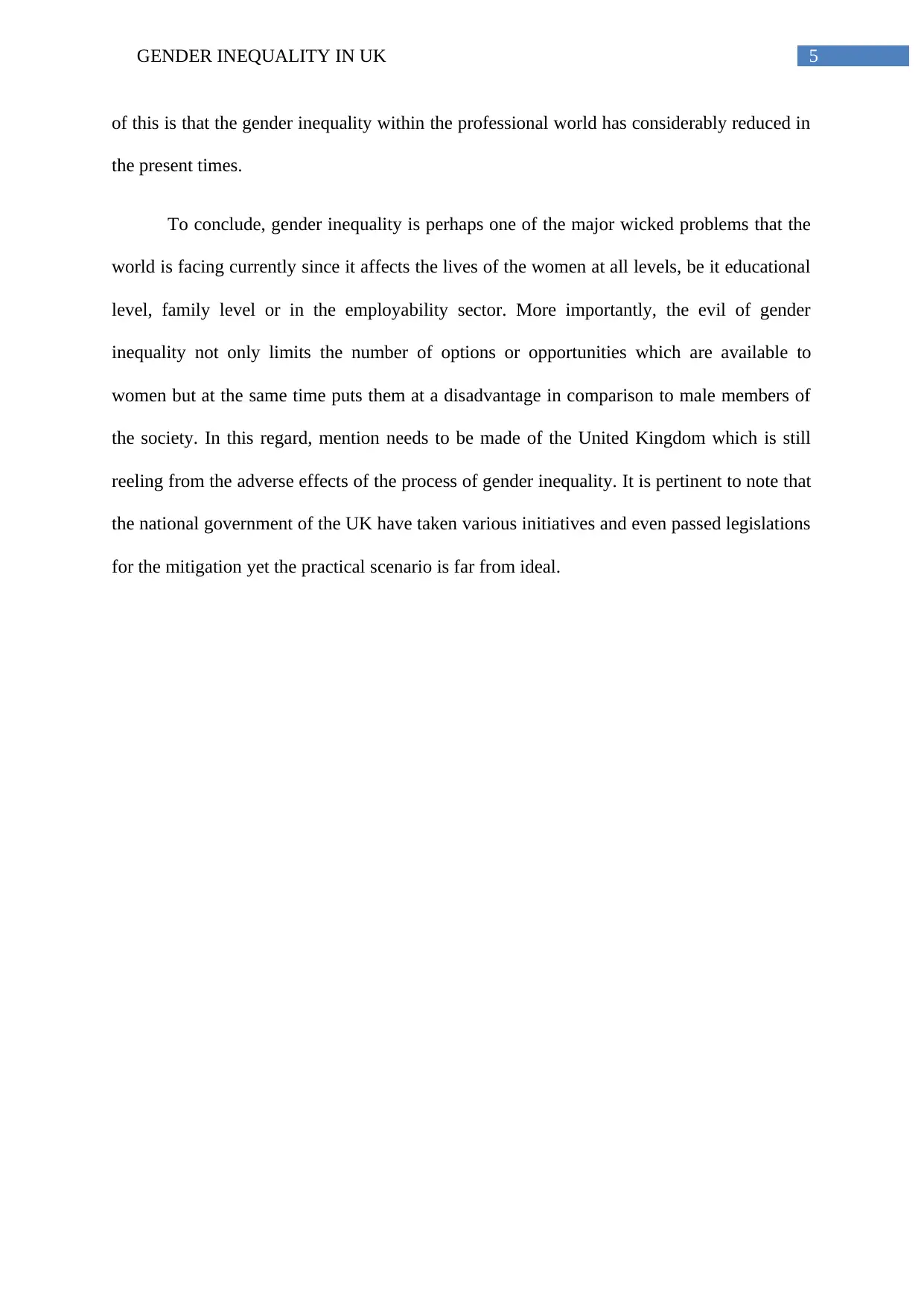
5GENDER INEQUALITY IN UK
of this is that the gender inequality within the professional world has considerably reduced in
the present times.
To conclude, gender inequality is perhaps one of the major wicked problems that the
world is facing currently since it affects the lives of the women at all levels, be it educational
level, family level or in the employability sector. More importantly, the evil of gender
inequality not only limits the number of options or opportunities which are available to
women but at the same time puts them at a disadvantage in comparison to male members of
the society. In this regard, mention needs to be made of the United Kingdom which is still
reeling from the adverse effects of the process of gender inequality. It is pertinent to note that
the national government of the UK have taken various initiatives and even passed legislations
for the mitigation yet the practical scenario is far from ideal.
of this is that the gender inequality within the professional world has considerably reduced in
the present times.
To conclude, gender inequality is perhaps one of the major wicked problems that the
world is facing currently since it affects the lives of the women at all levels, be it educational
level, family level or in the employability sector. More importantly, the evil of gender
inequality not only limits the number of options or opportunities which are available to
women but at the same time puts them at a disadvantage in comparison to male members of
the society. In this regard, mention needs to be made of the United Kingdom which is still
reeling from the adverse effects of the process of gender inequality. It is pertinent to note that
the national government of the UK have taken various initiatives and even passed legislations
for the mitigation yet the practical scenario is far from ideal.
⊘ This is a preview!⊘
Do you want full access?
Subscribe today to unlock all pages.

Trusted by 1+ million students worldwide
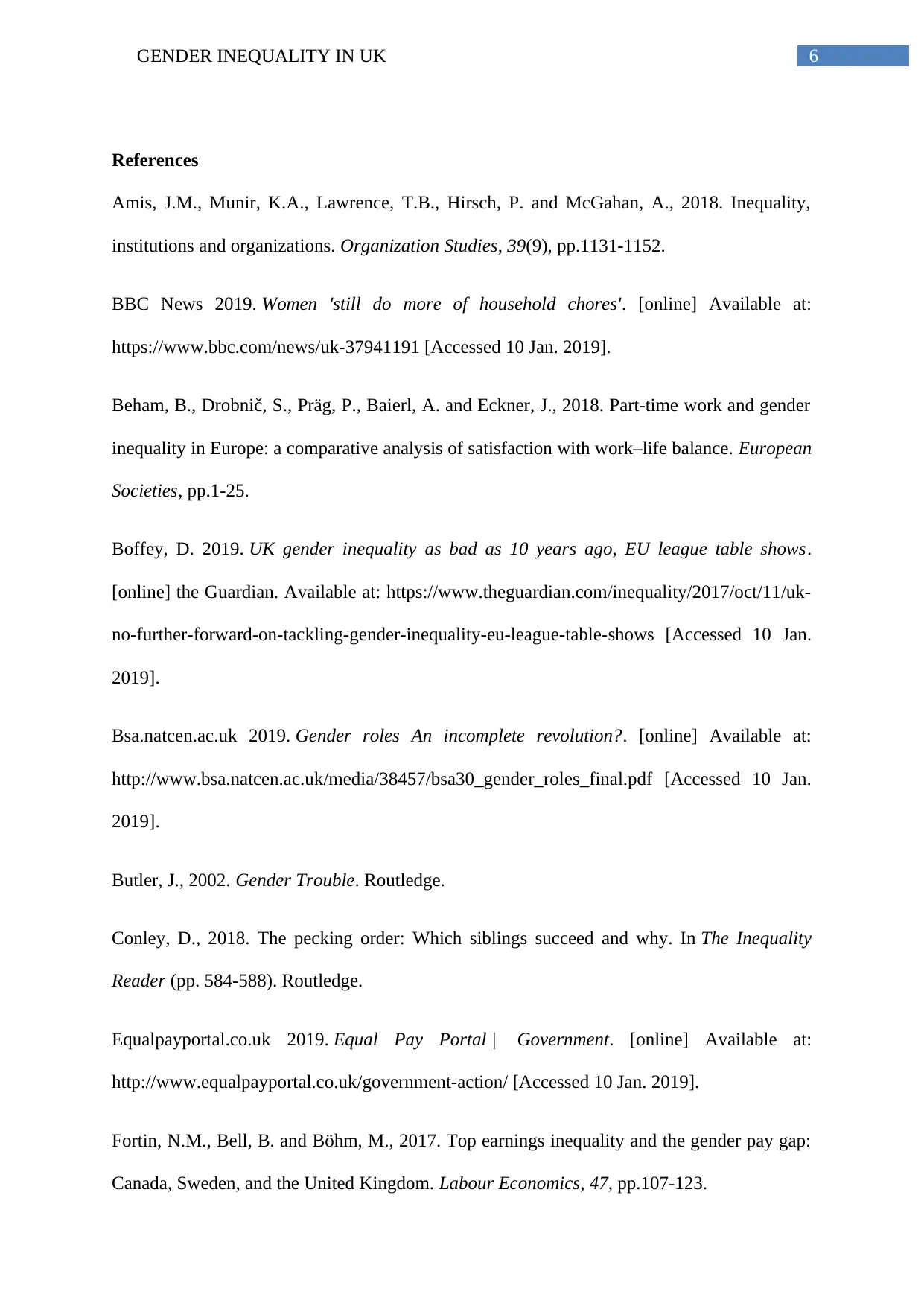
6GENDER INEQUALITY IN UK
References
Amis, J.M., Munir, K.A., Lawrence, T.B., Hirsch, P. and McGahan, A., 2018. Inequality,
institutions and organizations. Organization Studies, 39(9), pp.1131-1152.
BBC News 2019. Women 'still do more of household chores'. [online] Available at:
https://www.bbc.com/news/uk-37941191 [Accessed 10 Jan. 2019].
Beham, B., Drobnič, S., Präg, P., Baierl, A. and Eckner, J., 2018. Part-time work and gender
inequality in Europe: a comparative analysis of satisfaction with work–life balance. European
Societies, pp.1-25.
Boffey, D. 2019. UK gender inequality as bad as 10 years ago, EU league table shows.
[online] the Guardian. Available at: https://www.theguardian.com/inequality/2017/oct/11/uk-
no-further-forward-on-tackling-gender-inequality-eu-league-table-shows [Accessed 10 Jan.
2019].
Bsa.natcen.ac.uk 2019. Gender roles An incomplete revolution?. [online] Available at:
http://www.bsa.natcen.ac.uk/media/38457/bsa30_gender_roles_final.pdf [Accessed 10 Jan.
2019].
Butler, J., 2002. Gender Trouble. Routledge.
Conley, D., 2018. The pecking order: Which siblings succeed and why. In The Inequality
Reader (pp. 584-588). Routledge.
Equalpayportal.co.uk 2019. Equal Pay Portal | Government. [online] Available at:
http://www.equalpayportal.co.uk/government-action/ [Accessed 10 Jan. 2019].
Fortin, N.M., Bell, B. and Böhm, M., 2017. Top earnings inequality and the gender pay gap:
Canada, Sweden, and the United Kingdom. Labour Economics, 47, pp.107-123.
References
Amis, J.M., Munir, K.A., Lawrence, T.B., Hirsch, P. and McGahan, A., 2018. Inequality,
institutions and organizations. Organization Studies, 39(9), pp.1131-1152.
BBC News 2019. Women 'still do more of household chores'. [online] Available at:
https://www.bbc.com/news/uk-37941191 [Accessed 10 Jan. 2019].
Beham, B., Drobnič, S., Präg, P., Baierl, A. and Eckner, J., 2018. Part-time work and gender
inequality in Europe: a comparative analysis of satisfaction with work–life balance. European
Societies, pp.1-25.
Boffey, D. 2019. UK gender inequality as bad as 10 years ago, EU league table shows.
[online] the Guardian. Available at: https://www.theguardian.com/inequality/2017/oct/11/uk-
no-further-forward-on-tackling-gender-inequality-eu-league-table-shows [Accessed 10 Jan.
2019].
Bsa.natcen.ac.uk 2019. Gender roles An incomplete revolution?. [online] Available at:
http://www.bsa.natcen.ac.uk/media/38457/bsa30_gender_roles_final.pdf [Accessed 10 Jan.
2019].
Butler, J., 2002. Gender Trouble. Routledge.
Conley, D., 2018. The pecking order: Which siblings succeed and why. In The Inequality
Reader (pp. 584-588). Routledge.
Equalpayportal.co.uk 2019. Equal Pay Portal | Government. [online] Available at:
http://www.equalpayportal.co.uk/government-action/ [Accessed 10 Jan. 2019].
Fortin, N.M., Bell, B. and Böhm, M., 2017. Top earnings inequality and the gender pay gap:
Canada, Sweden, and the United Kingdom. Labour Economics, 47, pp.107-123.
Paraphrase This Document
Need a fresh take? Get an instant paraphrase of this document with our AI Paraphraser
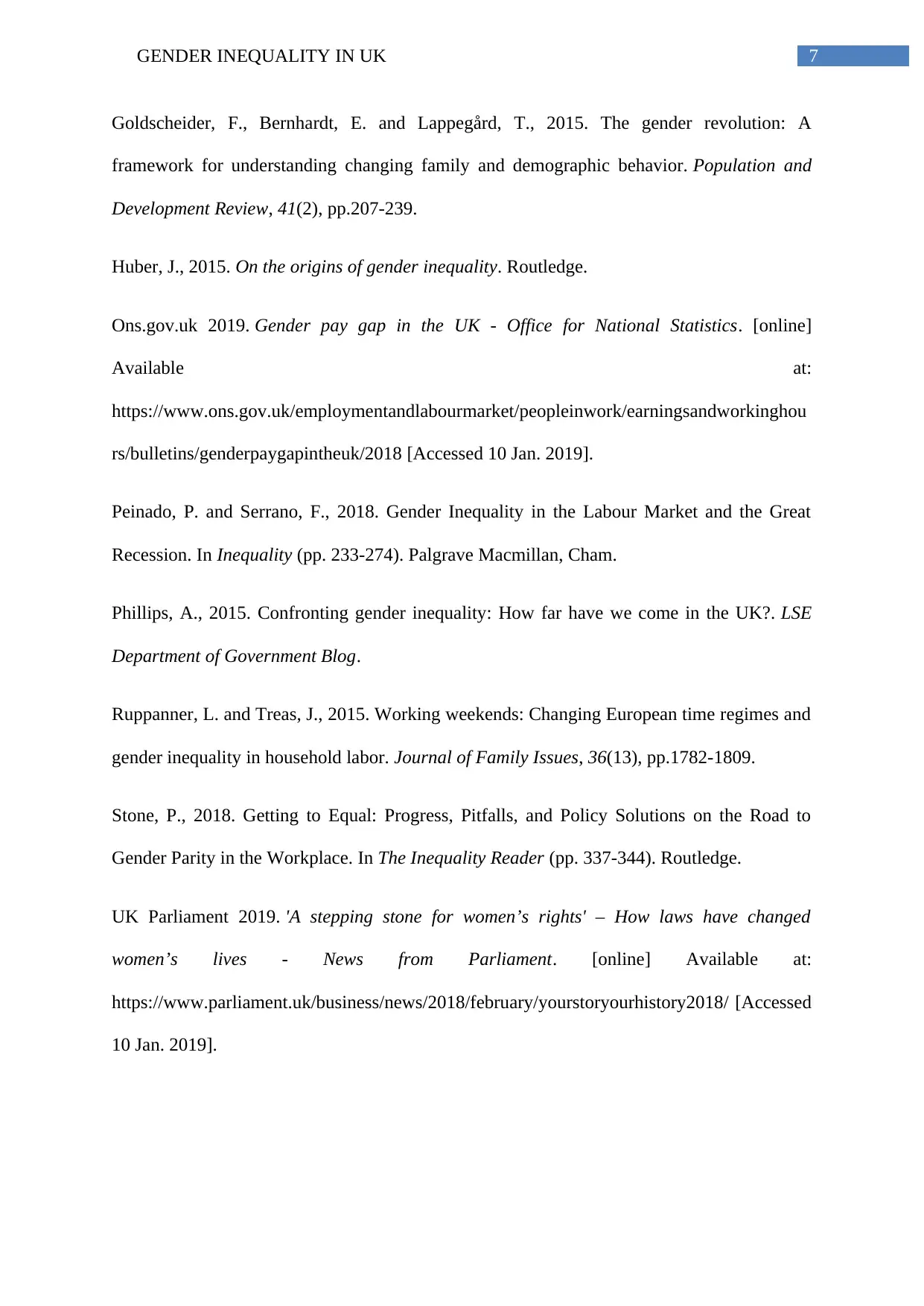
7GENDER INEQUALITY IN UK
Goldscheider, F., Bernhardt, E. and Lappegård, T., 2015. The gender revolution: A
framework for understanding changing family and demographic behavior. Population and
Development Review, 41(2), pp.207-239.
Huber, J., 2015. On the origins of gender inequality. Routledge.
Ons.gov.uk 2019. Gender pay gap in the UK - Office for National Statistics. [online]
Available at:
https://www.ons.gov.uk/employmentandlabourmarket/peopleinwork/earningsandworkinghou
rs/bulletins/genderpaygapintheuk/2018 [Accessed 10 Jan. 2019].
Peinado, P. and Serrano, F., 2018. Gender Inequality in the Labour Market and the Great
Recession. In Inequality (pp. 233-274). Palgrave Macmillan, Cham.
Phillips, A., 2015. Confronting gender inequality: How far have we come in the UK?. LSE
Department of Government Blog.
Ruppanner, L. and Treas, J., 2015. Working weekends: Changing European time regimes and
gender inequality in household labor. Journal of Family Issues, 36(13), pp.1782-1809.
Stone, P., 2018. Getting to Equal: Progress, Pitfalls, and Policy Solutions on the Road to
Gender Parity in the Workplace. In The Inequality Reader (pp. 337-344). Routledge.
UK Parliament 2019. 'A stepping stone for women’s rights' – How laws have changed
women’s lives - News from Parliament. [online] Available at:
https://www.parliament.uk/business/news/2018/february/yourstoryourhistory2018/ [Accessed
10 Jan. 2019].
Goldscheider, F., Bernhardt, E. and Lappegård, T., 2015. The gender revolution: A
framework for understanding changing family and demographic behavior. Population and
Development Review, 41(2), pp.207-239.
Huber, J., 2015. On the origins of gender inequality. Routledge.
Ons.gov.uk 2019. Gender pay gap in the UK - Office for National Statistics. [online]
Available at:
https://www.ons.gov.uk/employmentandlabourmarket/peopleinwork/earningsandworkinghou
rs/bulletins/genderpaygapintheuk/2018 [Accessed 10 Jan. 2019].
Peinado, P. and Serrano, F., 2018. Gender Inequality in the Labour Market and the Great
Recession. In Inequality (pp. 233-274). Palgrave Macmillan, Cham.
Phillips, A., 2015. Confronting gender inequality: How far have we come in the UK?. LSE
Department of Government Blog.
Ruppanner, L. and Treas, J., 2015. Working weekends: Changing European time regimes and
gender inequality in household labor. Journal of Family Issues, 36(13), pp.1782-1809.
Stone, P., 2018. Getting to Equal: Progress, Pitfalls, and Policy Solutions on the Road to
Gender Parity in the Workplace. In The Inequality Reader (pp. 337-344). Routledge.
UK Parliament 2019. 'A stepping stone for women’s rights' – How laws have changed
women’s lives - News from Parliament. [online] Available at:
https://www.parliament.uk/business/news/2018/february/yourstoryourhistory2018/ [Accessed
10 Jan. 2019].
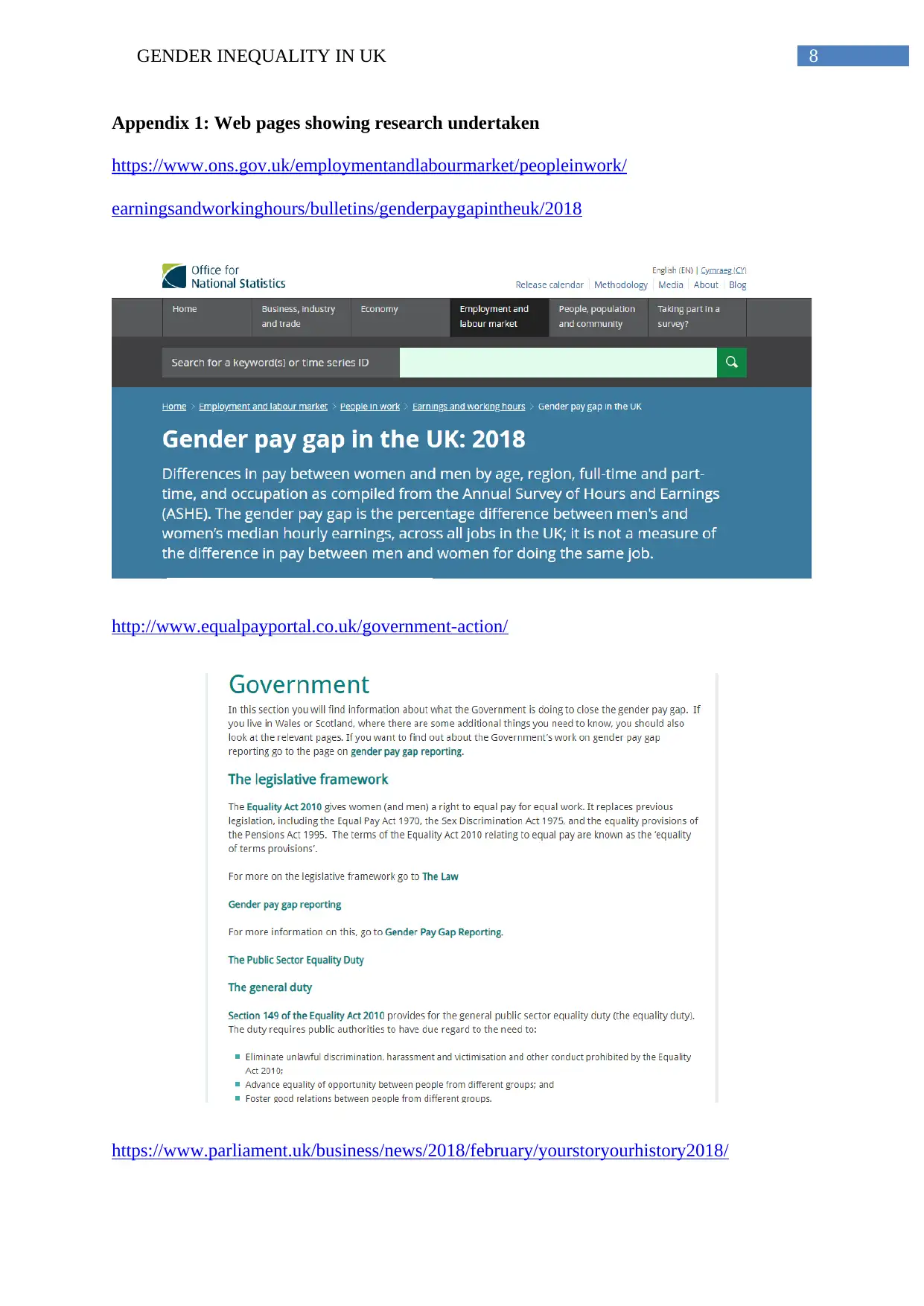
8GENDER INEQUALITY IN UK
Appendix 1: Web pages showing research undertaken
https://www.ons.gov.uk/employmentandlabourmarket/peopleinwork/
earningsandworkinghours/bulletins/genderpaygapintheuk/2018
http://www.equalpayportal.co.uk/government-action/
https://www.parliament.uk/business/news/2018/february/yourstoryourhistory2018/
Appendix 1: Web pages showing research undertaken
https://www.ons.gov.uk/employmentandlabourmarket/peopleinwork/
earningsandworkinghours/bulletins/genderpaygapintheuk/2018
http://www.equalpayportal.co.uk/government-action/
https://www.parliament.uk/business/news/2018/february/yourstoryourhistory2018/
⊘ This is a preview!⊘
Do you want full access?
Subscribe today to unlock all pages.

Trusted by 1+ million students worldwide
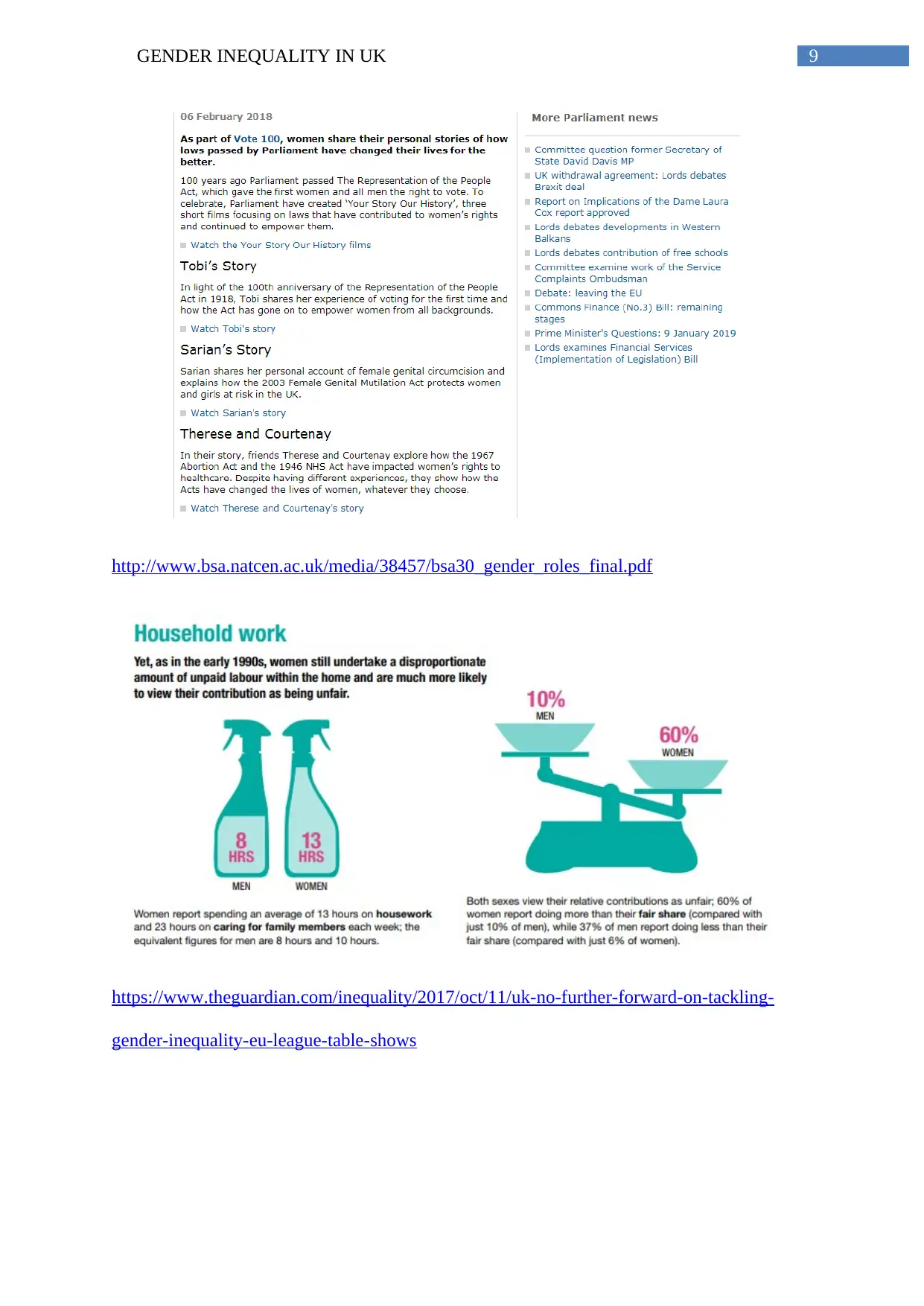
9GENDER INEQUALITY IN UK
http://www.bsa.natcen.ac.uk/media/38457/bsa30_gender_roles_final.pdf
https://www.theguardian.com/inequality/2017/oct/11/uk-no-further-forward-on-tackling-
gender-inequality-eu-league-table-shows
http://www.bsa.natcen.ac.uk/media/38457/bsa30_gender_roles_final.pdf
https://www.theguardian.com/inequality/2017/oct/11/uk-no-further-forward-on-tackling-
gender-inequality-eu-league-table-shows
Paraphrase This Document
Need a fresh take? Get an instant paraphrase of this document with our AI Paraphraser
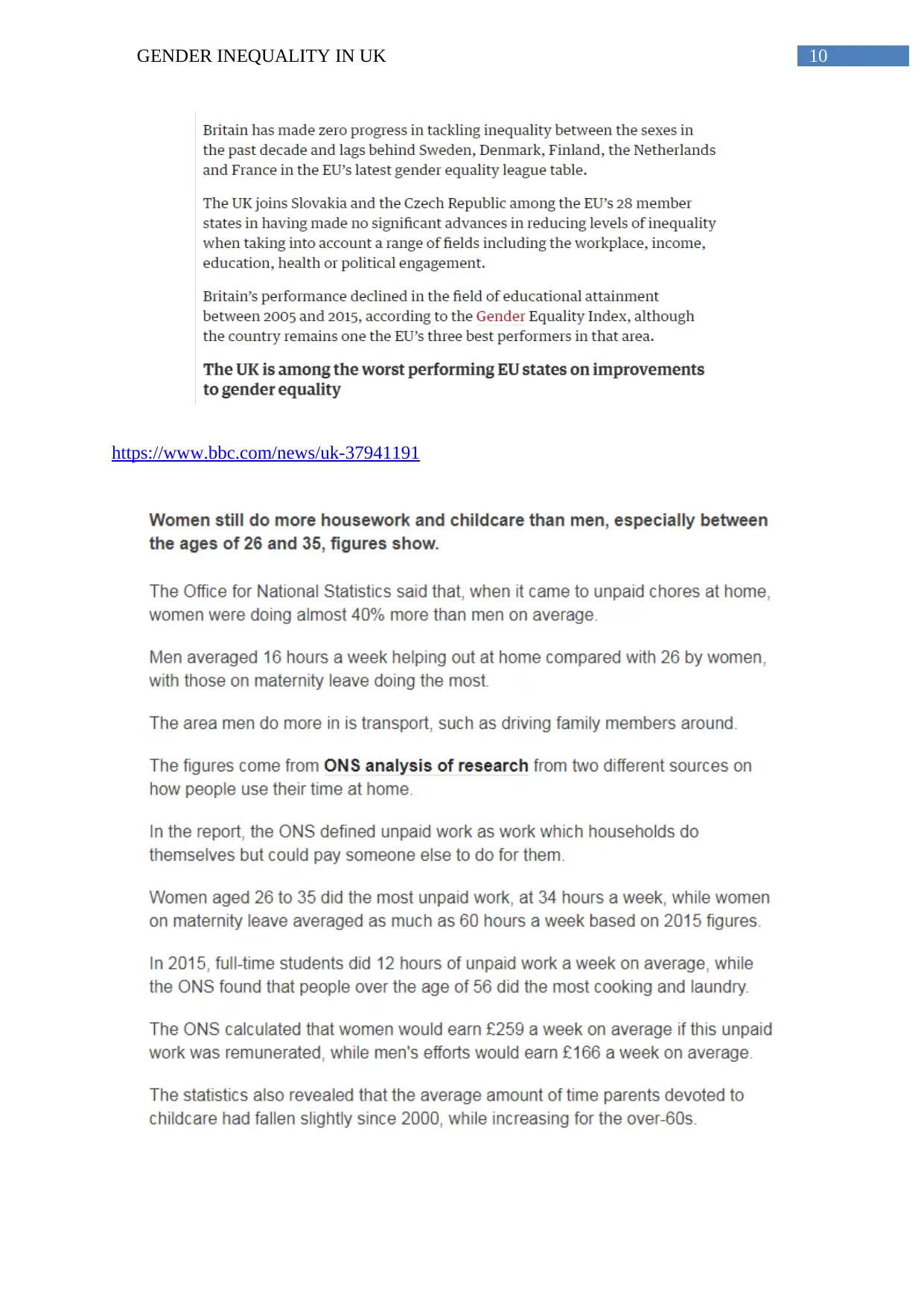
10GENDER INEQUALITY IN UK
https://www.bbc.com/news/uk-37941191
https://www.bbc.com/news/uk-37941191
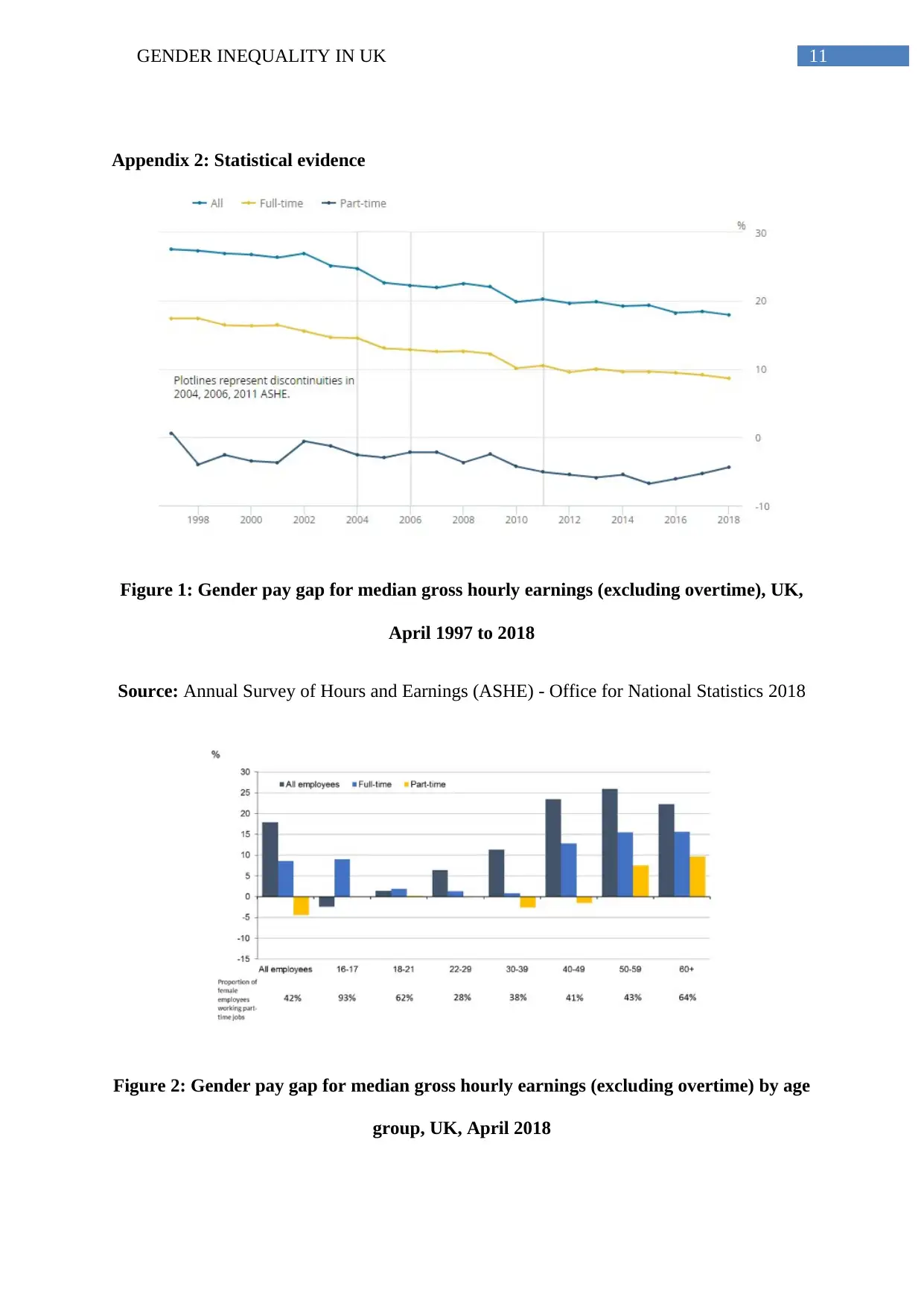
11GENDER INEQUALITY IN UK
Appendix 2: Statistical evidence
Figure 1: Gender pay gap for median gross hourly earnings (excluding overtime), UK,
April 1997 to 2018
Source: Annual Survey of Hours and Earnings (ASHE) - Office for National Statistics 2018
Figure 2: Gender pay gap for median gross hourly earnings (excluding overtime) by age
group, UK, April 2018
Appendix 2: Statistical evidence
Figure 1: Gender pay gap for median gross hourly earnings (excluding overtime), UK,
April 1997 to 2018
Source: Annual Survey of Hours and Earnings (ASHE) - Office for National Statistics 2018
Figure 2: Gender pay gap for median gross hourly earnings (excluding overtime) by age
group, UK, April 2018
⊘ This is a preview!⊘
Do you want full access?
Subscribe today to unlock all pages.

Trusted by 1+ million students worldwide
1 out of 13
Your All-in-One AI-Powered Toolkit for Academic Success.
+13062052269
info@desklib.com
Available 24*7 on WhatsApp / Email
![[object Object]](/_next/static/media/star-bottom.7253800d.svg)
Unlock your academic potential
Copyright © 2020–2025 A2Z Services. All Rights Reserved. Developed and managed by ZUCOL.


